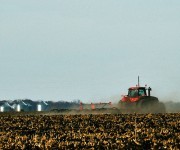Macomb PaynesConventional farmers add a lot of synthetic nitrogen fertilizer to the soil. Most crops only absorb around 30 to 50 percent of it, leaving many pounds of nitrogen behind. When that soil is tilled, nitrogen can enter the atmosphere as nitrous oxide, a highly potent greenhouse gas, or drain into waterways, before eventually wreaking havoc on our bays and oceans.
But that’s not the only downside to tilling farmland. It releases carbon that had been sequestered into the atmosphere, and reduces the amount of water the soil would otherwise retain, putting even greater stress on the world’s emptying water tables. When done regularly, tilling also causes soil to erode. Take all this into account and it’s no surprise that “no-till farming” has gained popularity in recent years.
For most of the 20th century, American farmers tilled under the crop residue (like empty corn stalks) left behind in their fields after harvesting. This practice turns up as much as six inches of soil and is usually done to stop weed growth, though it also loosens the soil to make the next planting easier.
No-till farming, on the other ha... Read more
